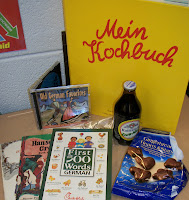'Tis the season for winter parties and Christmas decorations! This came from an old Mailbox magazine, and it's super quick and easy to do.
Just take three popsicle sticks, have the students color their three sticks with a green crayon or magic marker. Glue the sides together to make a triangle. Use a foam star glitter sticker at the top of the tree. Glue on the 'jewels' and let it dry. Once it's all dried and set, tie on a string so that it can hang from the tree.
I got all of my supplies from the craft section of Walmart. You can also use glitter instead of 'jewels'.
Just take three popsicle sticks, have the students color their three sticks with a green crayon or magic marker. Glue the sides together to make a triangle. Use a foam star glitter sticker at the top of the tree. Glue on the 'jewels' and let it dry. Once it's all dried and set, tie on a string so that it can hang from the tree.
I got all of my supplies from the craft section of Walmart. You can also use glitter instead of 'jewels'.
















